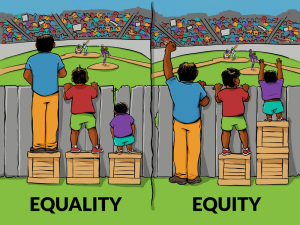“If you aren’t in over your head, how do you know how tall you are?”
T.S. Eliott
Keeping a growth mindset with our students can be challenging. However, let’s take time to ponder this challenge through the opportunities below:
- teach students the difference between equity and equality
- develop strategies to challenge all students responsively and responsibly
- set and communicate high expectations of all students
Equity vs. Equality
When you talk to your students about equity vs. equality, do you think an image comes to their mind that looks something like this?

Probably, not. Equity vs. equality is an abstract concept that students will need to be able to discern. The simplicity of this image should make that meaning come to life for them. When we are all equal we get the same. However, as evidenced by this image, one size fits all does not work. Equity, on the other hand, is defined as being “the quality of being fair.” Open a dialogue of equity in your classrooms. You can use the chart below to jump start the dialogue.

Personalized Learning and Challenge
Sir Ken Robinson, an educational researcher, writer and speaker is well known for his TED Talk, “Do Schools Kill Creativity?” A 19 minute talk that has been linked here, and is 19 minutes well spent.
As we venture into personalized learning with our students, take time to think about how we can challenge our students to see what their learning styles are, what are their interests and what are their passions. Why not present them with learning opportunities such as 20% time, passion projects, genius hour or inquiry-based learning.
20% time. Provide students an opportunity to design their own learning with 20% time. Google implemented this as a company policy that allows employees to spend 20% of their time on projects of high interest to them. They found this sparked innovation and creativity. And by the way, Gmail was an outcome of an employee’s innovation and creativity — something we all can’t live without!
Passion projects. Students create an essential question that drives their learning. They work through determining what they already know, what they are interested in learning about, and develop their plan of action based off this. Teachers give the students the opportunity to direct their own research, design a learning process, reflect, and most importantly share their learning experiences.
Genius hour. Students are presented with an opportunity to design their learning, based on their passions and interests by allotting one hour per week to their individual pursuits. Teachers facilitate the learning and coach students throughout the learning process.
Inquiry-based learning. Students are driven to learn based on questions they have about a given topic. The teacher doesn’t share what students should know or will learn,though the teacher launches a lesson by putting students in the driver’s seat and encouraging them to learn based on their questions and the inquiry process. During inquiry based learning, the teacher responds to students by asking additional questions,which may spark curiosity and investigation.
If anyone has an interest in delving into any of the processes above, please fill out a coaching request, and we will be happy to work with you and your students. Click here for link to coaching request form.
Setting High Expectations
Robert Rosenthal is a renowned researcher on the science of expectancy – how our expectations can influence outcomes. He developed what he believed was the the four factors that influence expectations. The chart below summarizes the four factors of what influences high expectations.

The formula – hard work + high expectations = the perfect conditions for facilitating a growth mindset in the classroom.
Knowing the difference between equity vs. equality, challenging our students responsively and responsibly, and setting and communicating high expectations for all your students is a win win situation for all.
To you and your loved ones — have a happy and healthy holiday season. Can’t wait to see what the new year brings with our students.
These resources have been collected from The Growth Mindset Coach: A Teacher’s Month by Month Handbook for Empowering Students to achieve by Annie Brock and Heather Hundle